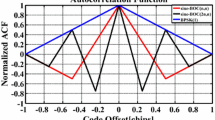Abstract
The Galileo E5 or COMPASS B2 signal is the most precision civil and most challenging navigation signal which will be available in the near future for regular navigation. The excellent performance of this signal was reached by Alternative Binary Offset Carrier (AltBOC) modulation, which is specially designed for high precision range measurement and which is featured by extremely wide bandwidth. However, this modulation presents some drawbacks. The most severe one is the ambiguity problem in AltBOC signal acquisition and tracking, which introduces a large bias in the pseudo-range measurement. In order to solve this problem, an unambiguous tracking method based on a pseudo correlation function for AltBOC(15,10) modulation signal is proposed in this paper. It employs two local signals and a novel combination function, which completely removes side peaks from the correlation function while keeping the sharp main peak. Impacts of multipath on the proposed method are also investigated. Simulation results demonstrate that the proposed method is totally unambiguous while exhibiting an average multipath performance with respect to the existing unambiguous tracking methods.
Similar content being viewed by others
Abbreviations
- GNSS:
-
Global navigation satellite systems
- AltBOC:
-
Alternative binary offset carrier
- PCF:
-
Pseudo correlation function
- ACF:
-
Autocorrelation function
- CCF:
-
Cross-correlation function
- PSD:
-
Power spectral density
- SC:
-
Side-peaks cancellation
- NEML:
-
Narrow early-minus-late
References
United Nations. (2010). Current and planned global and regional navigation satellite systems and satellite-based augmentations systems. In International committee on global navigation satellite systems provider’s forum. New York.
European Union. (2010). European GNSS (Galileo) open service signal in space interface control document. Document subject to terms of use and disclaimers p. II–III OD SIS ICD, Issue 1.1.
Tang Z. P., Zhou H. W., Wei J. L. et al (2011) TD-AltBOC: A new COMPASS B2 modulation. Science China Physics, Mechanics & Astronomy 54(6): 1014–1021
Kaplan, E. D., & Hegarty, C. (2006). Understanding GPS: Principles and applications. Artech House Mobile Communications Series.
Nagaraj, C. S., Andrew G. D., & Chris, R. (2011). On efficient wideband GNSS signal design. In Proceeding of ION international technical meeting (pp. 401–410), San Diego, CA.
Julien, O., Macabiau, C., & Issler, J. (2009). Ionospheric delay estimation strategies using Galileo E5 signals only. In Proceeding of ION international technical meeting (pp. 3128–3141), Savannah, GA.
Nagaraj, C. S., & Andrew G. D. (2008). An analysis of Galileo E5 signal acquisition strategies. In Proceeding of the European Nav Conference, ENC GNSS (pp. 186–190), Toulouse.
Kim S., Yoo S., Yoon S., Kim S. Y. (2009) AltBOC and CBOC correlation functions for GNSS signal synchronization. Computer Science 5593(2009): 325–334
Yao Z., Lu M., Feng Z. (2010) Pseudo-correlation-function-based unambiguous tracking technique for Sine-BOC signals. IEEE Transaction on Aerospace and Electronic System 46(4): 1782–1796
Yao, Z., & Lu, M. (2011). Side-peaks cancellation analytic design framework with applications in BOC signals unambiguous processing. In Proceeding of ION international technical meeting (pp. 775–785), San Diego, CA.
Halunga S. C., Vizireanu D. N., Fratu O. (2010) Imperfect cross-correlation and amplitude balance effects on conventional multiuser decoder with turbo encoding. Digital Signal Processing 20(1): 191–200
Halunga S. C., Vizireanu D. N. (2010) Performance evaluation for conventional and MMSE multiuser detection algorithms in imperfect reception conditions. Digital Signal Processing 20(1): 166–178
Rebeyrol, E., Macabiau, C., Lestarquit, L., et al. (2005). BOC power spectrum densities. In Proceeding of ION-NTM (pp. 769–778), Long Beach, California.
Rodriguez J. A. (2008) On generalized signal waveforms for satellite navigation. University FAF Munich, Munich, Germany
Aleksandar, J., Youssef T., Cyril, B., & Pierre, F. (2010). Multipath mitigation techniques for CBOC, TMBOC and AltBOC signals using advanced correlators architectures. In Proceeding of ION PLANS (pp. 1127–1136), Indian Wells, CA, USA.
Nagaraj, C. S. (2009). Code phase multipath mitigation by exploiting the frequency diversity in Galileo E5 AltBOC. In Proceedig of ION international technical meeting (pp. 3219–3233), Savannah, GA.
Rouabah K., Chikouche D., Bouttout F., Harba R., Ravier P. (2011) GPS/Galileo multipath mitigation using the first side peak of double delta correlator. Wireless Personal Communications 60(2): 321–333
Author information
Authors and Affiliations
Corresponding author
Rights and permissions
About this article
Cite this article
Chen, H., Wang, R., Jia, W. et al. An Unambiguous Tracking Method Based on Pseudo Correlation Function for AltBOC(15,10) Signal. Wireless Pers Commun 69, 1347–1364 (2013). https://doi.org/10.1007/s11277-012-0637-z
Published:
Issue Date:
DOI: https://doi.org/10.1007/s11277-012-0637-z




